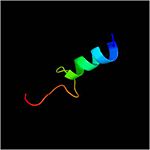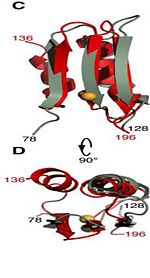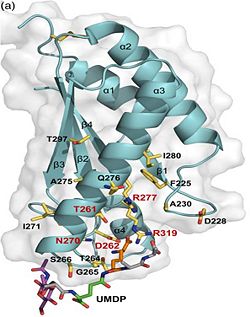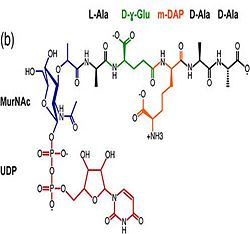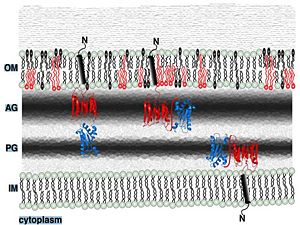Mycobacterium tuberculosis ArfA Rv0899
From Proteopedia
| Line 42: | Line 42: | ||
3. BON <ref>PMID: 12878000 </ref> | 3. BON <ref>PMID: 12878000 </ref> | ||
Nitrogen fixation and or nitrogen metabolism | Nitrogen fixation and or nitrogen metabolism | ||
| + | Contributes for structural strength to the b cell wall | ||
==Localization in membrane== | ==Localization in membrane== | ||
Revision as of 22:43, 23 January 2015
IntroductionThe Rv0899 ArfA protein [ARFA_MYCTU] from Mycobacterium tuberculosis H37Rv belongs to the OmpA (outer membrane protein A) family of outer membrane proteins and has been proposed to act as an outer membrane porin with ion channel activity and contributes to the bacterium's adaptation to the acidic environment in phagosome [1] during infection [1]. Rv0899 protein encoded by an ammonia release facilator operon that is necessary for rapid ammonia secretion, pH neutralization and adaptation to acidic environments in vitro. Two Mycobacterium tuberculosis H37Rv genes (Rv0900 [ARFB_MYCTU] and Rv0901 [ARFC_MYCTU] ) adjacent to Rv0899 also encode putative membrane proteins, and are found exclusively in association with Rv0899 in the same pathogenic mycobacteria, suggesting that the three may constitute an operon dedicated to a common function. Asparagine is the primary ammonia source for Mycobacterium tuberculosis H37Rv at acidic pH [2]. The deletion of this gene impairs the uptake of some water-soluble substances, such as serine, glucose, and glycerol [3]. Structural highlights
Structure SectionThe 326-residue Rv0899 ArfA contains three domains: an N-terminal domain (M domain) (residues 1-72) which includes a sequence of 20 hydrophobic amino acids required for membrane translocation. Residues form a mixed alpha/beta-globular structure, encompassing two independently folded modules corresponding to the B and C domains connected by a flexible linker. The central B domain folds with three parallel/antiparallel Alpha Helices packed against six parallel/antiparallel Beta Strands that form a flat beta-sheet. The B domain has homology with conserved putative (bacterial OsmY and nodulation) superfamily domains and conserved Gly95 and Gly164 [2]. is Hydrophobic, while the exterior is Polar and predominantly acidic. The two subdomains are symmetric about α2, and their backbone atoms can be aligned with a RMSD [3] of 1.8Å, by performing a 180° rotation of either one around an axis normal to the 6-stranded β-sheet.
The C domain has homology to the OmpA-C-like superfamily of periplasmic peptidoglycan-binding sequences, found in several types of bacterial membrane proteins.The C domain of wild-type ArfA into four Beta Strands and four Alpha Helices.Three parallel (β1, β2, β3) and one antiparallel (β4) β-strands form a four-stranded β-sheet (β1–β4-β2–β3) that packs against three α-helices (α1, α2, α3), while a fourth helix (α4) extends from the N-terminus of β4. The structure by disulfide bond between C208 and C250, by a network of hydrophobic contacts between α1, α2 and β4 (L211, I215, V243, L247, Ile323 and V325) between side chains and by a hydrogen bond between the backbone amide of V325 and the side-chain carbonyl of Q212. Putative functions1. Acquisition of Zn(2+) ions by Ligand [4]. 2. Bacterium's adaptation to the acidic environment of the phagosome during infection by: a) deamidation of the amino acid pair , located at the end of α1 and preceding L3, a pH-dependent reaction whereby Asn is converted to Asp and ammonia is released. Asparagine residues preceding glycine, and situated in conformationally flexible regions of proteins, are frequently deamidated, with potentially significant consequences for protein regulation and function [5].
b) PH-dependent conformational dynamics of hydrophobic cluster of 232, 225, 240, 244, 281, 285 and a more ordered structure like a flap at . Its functions in acid stress protection and [peptidoglycan][4] binding site suggest a link between the acid stress response and the physicochemical properties of the mycobacterial cell wall. These residues are strictly conserved in the OmpA -like family [6]. 3. BON [7] Nitrogen fixation and or nitrogen metabolism Contributes for structural strength to the b cell wall Localization in membraneReferences
| ||||||||||||||||
